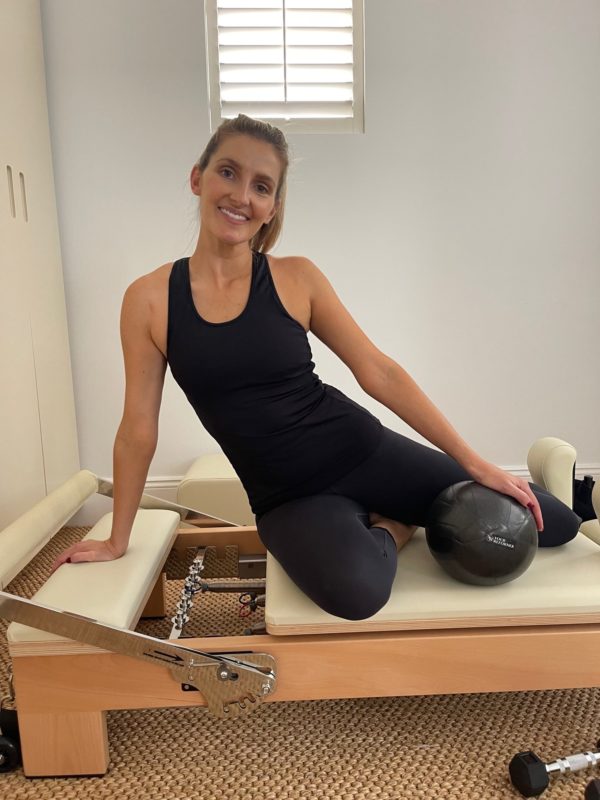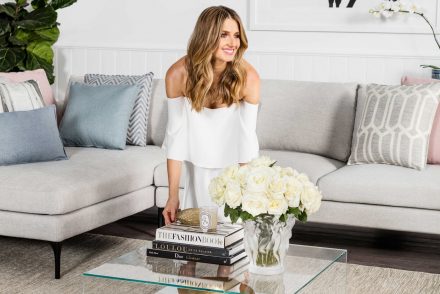When it comes to workouts I think the best kind is one that you can commit to and do consistently. As a busy mum of two and a full slate of work commitments, plus running my own business, the time I have to exercise isn’t much. This means, I generally gravitate towards things that I can easily do at home, or very close to home. Enter reformer Pilates, which I absolutely love doing in a studio, but these days find it hard to do a class in person. So, I’ve rented a bed from Your Reformer to keep at home and it has been a game changer. I’m able to follow their online classes at home, and I can squeeze in a workout when it’s convenient. Exercise is so important for keeping me strong both mentally and physically, so I’ve loved being able to embrace it more regularly.
If you’re new to reformer Pilates and are wondering what the bed actually does or how it differs to regular mat Pilates, you’re not alone. So, I asked the founder of Your Reformer and Pilates instructor Emma Stallworthy to answer some popular questions when it comes to reformer Pilates.
What is reformer Pilates? What’s involved in a typical class?
Reformer Pilates is a style of movement that incorporates the reformer apparatus to enhance the Pilates repertoire. The reformer provides greater variety of exercises and increases the challenge using tension with springs. The focus for any class is first building strength in your core, but a reformer class also provides you with a full body workout. Some modern pilates classes will incorporate props with your reformer workouts to spice things up and keep things interesting and challenging! It’s a lot of fun.
What is the main difference between reformer Pilates and mat Pilates?
The main difference is the use of the reformer machine. Mat classes typically focus on the core predominantly, and can lack in variety of exercises. Using the reformer, we can focus on all muscle groups, not just the core, and build further on strengthening using springs for load. Traditionally, reformer Pilates was designed to build form and strength to enable one to progress to the mat work repertoire which can seem really challenging if you are weak in your core or lacking mobility. However reformer really does have many more benefits to this and is now far widely preferred for both modern and contemporary classes.
What are the benefits of doing reformer Pilates?
So many – where to start! Great for building strength and muscle tone, as well as stability through the joints.
It connects the mind with your body’s movements, which essentially is a mindfulness practice, thereby helping to reduce stress and anxiety. Originally designed for dancers, a reformer workout will focus on both strengthening and lengthening muscle movements, and it’s low impact so you can keep coming back. It’s very functional, building strength in the core which so many of us lack, thereby reducing the chance of back pain. It also helps to improve or counteract bad posture, for example the hunch back caused by sitting at a desk all day, breastfeeding or carrying children, looking over at our phones, etc. Plus it’s lots of fun.
Reformer Pilates is also great for rehabilitation. Clinical Pilates with a physio can really help you build strength and confidence back after an injury. The low impact nature of the exercises provide greater options to move than if you were nursing an injury in the gym.
How can someone get the most out of a reformer Pilates class?
Don’t push through an exercise if it doesn’t feel right. Form and technique is important for getting the greatest benefits from the exercise. Be present in your body and focus on the movement and cues the instructor is giving you. Rushing an exercise is a common mistake, slowing it down can often reap greater rewards out of the exercise. And most of all, smile and have fun with it!
What changes can you expect to your body when doing reformer Pilates? How long does it take to start to see results?
Improved posture and body confidence is a big one. Longer and leaner bodies are the typical results you get from consistent Pilates. Which, as a female, who doesn’t want longer leaner legs right? The time it takes to notice a difference, will depend on how consistent you are being, and how frequent. If you are say consistently practicing 2-3 times per week, expect to notice a difference in about 4-6 weeks (although you will feel different earlier). Most clients feel more energised, alert and positive very early on, which carries them through to where they start to see the physical changes.
How do you suggest a beginner take up reformer Pilates?
Of course with any new exercise, if you have concerns or injuries, checking with a health professional to get the green light. But the best way to start is with an introductory or beginner class. Perhaps you can find a local studio who offers an induction or introductory class, or of course if you’re a Your Reformer customer, we have filmed introductory and beginner classes to ease you into. There’s a lot to learn in a reformer class and it can be overwhelming so the first thing really is familiarise yourself with the machine itself, then going over basic exercises to build confidence and form.
For those dubious about Pilates being a strenuous workout, what do you say to that?
They clearly haven’t ever given it a go! Our male customers say this a lot, but are unsure about trying it with the stigma it’s a female-filled class, or not wanting to potentially embarrass themselves in front of others. We have so many of our customers feeding back to us that their partner has given it a go, in the comfort and privacy of their own home, and has loved it. They now have to fight over who gets to do a class first! More and more athletes are taking up reformer Pilates to complement their strenuous training regime. It’s low impact which makes it great for longevity, however it will certainly get the body working. In particular, reformer Pilates is great for targeting muscle imbalances, and smaller muscle groups that can get neglected in traditional gym workouts. For this reason, clients often remark how difficult the class felt, because they were working on their areas of weakness.
For someone who is busy and is keen to practice at home, is it really possible to get the same benefits/results from doing a class at home vs a studio?
Absolutely, in fact I’d argue more so. To get results, you need consistency, and really that is what we have been lacking mostly in the past couple of years with the pandemic. What having a bed at home enables you to do is commit to more sessions per week. In person sessions are excellent, the vibe and of course personal instruction to your form is not replicable, however you could keep your one class a week, and then supplement 2-3 extra classes at home that you may not have had time to get to otherwise. Plus you save money too!
Are there things someone should keep in mind if they do want to do reformer Pilates at home?
The machines aren’t small, so make sure you measure your space and allow enough room either side for the exercises (ideally at least 75cm either side of the bed with some room at the end near the footbar). For those space conscious or in apartments, we have a folding option which is ideal! We recommend you create a ‘wellness sanctuary’. It doesn’t need to be anything fancy, but just little touches that will help motivate and inspire you to practice your pilates. Then set a realistic schedule for yourself; are you morning, or is evening after the kids are in bed a better option? Do you have a partner or someone to support you if you need it so you can manage your workouts? And a good quality class instruction video to follow is important too.





No Comments